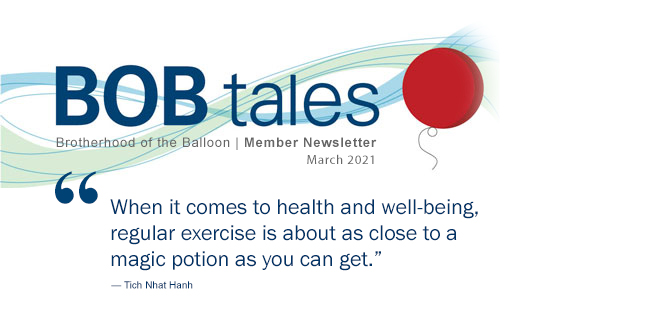
Dear Members (a note from Deb Hickey):
I’ve never been one to exercise regularly. I just don’t understand those Peloton junkies or gym rats. And what about those CrossFit addicts? Yikes. You couldn’t pay me to get up before dawn only to drive across town to do burpees and handstands with a bunch of diehard body builders. And who invented kettle bells?!
You know those relentless runners you see every morning? You know the ones – whether it’s 90 degrees or -4 – they’re out there in their neon activewear. And there you are, watching from the window, like a stalker … sipping mango pineapple tea, wearing your pink heart jammies … or maybe that’s just me.
In all seriousness, I know the importance of daily physical activity. I research and write about it all the time … as you know. What I don’t understand is how people get the motivation to get moving when it’s so much easier to read a book or watch Dr. Phil re-runs. The sofa is much more comfortable than the sidewalk. And I’m sorry, but the gym smells.
So, imagine my bewilderment when, a few weeks into COVID lockdown, I felt the urge to get outside and get my body moving. I looked at my dog. She looked at me. Was she thinking what I was thinking? I’m not sure what motivated me to throw on my sneakers and grab a handful of Yo-Doggy Yum Yum puppy treats, a couple of poop bags, and a water bottle and get into my car that day, but I did. Twenty minutes later, my spunky doodle, Lucy, and I found ourselves across town, hiking along a trail in Noon Hill Reservation (a 200-acre open space preserve located in my own hometown of Medfield, MA).
Hiking. Me.
And we did that nearly every day for the next few months – rain or shine – until mid-September when I broke my foot tripping over a sprinkler head in my back yard. BUT the point is – I’d found my “thing.” And not only was I getting exercise, I learned later on that I was also practicing mindfulness. At certain points during our adventures, I’d just stop and smell the air; listen to the wind blowing through the trees; notice the bird calls and the rustling of small animals in the leaves nearby. Sometimes I’d sit on a rock and just be. It gave me such peace. One time, while (thankfully) Lucy was preoccupied with a stick, I saw a huge doe a few yards away. She was beautiful. She was just standing there looking at me. I stared back, eyes wide, thankful that Lucy had plucked a branch from a shrub and was gnawing on it, unaware of the extraordinary creature before us. It was a moment I’ll never forget.
 I can’t wait for the winter snow to melt and my foot to return to semi-normal so I can go back to the reservation. Knowing that spring is right around the corner and the forest is waiting is one of the things that gets me through the winter blues and pandemic woes.
I can’t wait for the winter snow to melt and my foot to return to semi-normal so I can go back to the reservation. Knowing that spring is right around the corner and the forest is waiting is one of the things that gets me through the winter blues and pandemic woes.
Life has been tough lately. I think it’s so important to have something to look forward to – and something that gets your body moving and your mind focused on the present. If you hate exercising like me, consider activities you may never have thought about before. Any physical activity is good for you – whether it be gardening or cleaning your garage.
I didn’t even like walking my dog before I found the trails. And what I find most interesting when I’m hiking is that I have the urge to run through the forest – I get excited about what’s around the bend or what’s at the bottom of the hill. I’m not suggesting you’ll all love trail running but consider the many ways to get your body moving. You’d be surprised what it’ll do for your mental state, too.
And by the way, don’t discount dancing (by yourself or with a friend) or roughhousing with your kids or grandkids. Those things will keep you young.
In this month’s BOB Tales, learn about an exciting new technology – that goes beyond the latest MRI – that provides doctors with live, high-resolution ultrasound images of the prostate during the biopsy procedure. We have an update on Medicare’s New Rule and the argument and suggestion from the proton community. We share a sad story about a gentleman whose urologist believed PSA testing was overdone and therefore missed the growing cancer in his patient, allowing the disease to grow and metastasize. We answer the question – should you wait for the “best” COVID-19 vaccine or get what you can as soon as you can? We also share one member’s heartwarming response to our request for donations to proton research in return for a pre-published copy of the book, Don’t Just Stand There, about the late Dr. James M. Slater. And much more …
As always, we welcome and encourage your feedback. Please send an email to [email protected].
Deb Hickey
To print the BOB Tales newsletter or view the newsletter with a larger font size, click here for the PDF file.
In This Issue:
- Detecting Prostate Cancer with Advanced Micro-ultrasound
- Medicare’s New Rule Stifling Innovation: Why Proton Therapy Should be Excluded
- Sad Story with a Lesson
- Should You Wait for the “Best” COVID-19 Vaccine?
- Surpised and Humbled … One Member’s Reason for Giving and Video Summary of Treatment
- “Health Screenings and Vaccinations You Need in 2021”
- Gene Discovery Reveals Importance of Eating Greens



Detecting Prostate Cancer with Advanced Micro-ultrasound
Imaging Technology News published an article last month about an exciting new technology that helps doctors identify and target potentially cancerous lesions in the prostate during a biopsy.
Typically, when a doctor suspects cancer – if a patient’s PSA is elevated or a suspicious lump is detected by digital rectal exam – a prostate biopsy is ordered. The standard procedure for conducting a prostate biopsy involves the use of an ultrasound device to image the prostate while the urologist inserts a needle through the wall of the rectum (transrectal biopsy) to take multiple samples to look for cancer.
This technology is about 35 years old and has many deficiencies. The greatest drawback of the standard prostate biopsy is that the ultrasound produces a low-resolution image, which helps the urologist find the prostate, but not necessarily any cancerous lesions that might be present. For this reason, the traditional biopsy is often called a “blind biopsy.”
Dr. Brian Wodlinger, the article’s author, compared this old technology to “playing darts blindfolded,” which isn’t an exaggeration. He wrote, “It (the old technology) required the doctor to take an average of 12 random samples in the hopes of finding the cancer. This practice often misses the cancer or stops short of the edge of the abnormal tissue leading to the patient receiving a benign, or negative test result when they actually have prostate cancer, or a diagnosis of low-risk cancer when high-risk aggressive disease is actually present.”
Newer multi-parametric MRI (mp-MRI) technologies are helping urologists identify suspicious lesions within the prostate that can be targeted by the biopsy needle. There are two types of mp-MRI-guided biopsies, which Bob wrote about in the new edition of his book. One is called an mp-MRI fusion-guided biopsy, where a high-resolution image of the prostate is overlayed (fused) onto the ultrasound image in order to guide the biopsy needle to the right locations. The other is called an in-bore mp-MRI guided biopsy. In this case the biopsy needle is directed at the suspicious lesions in real-time, i.e. while the patient is in the MRI machine and the doctor is viewing the prostate and suspicious lesions while inserting the biopsy needle.
Micro-ultrasound Technology
Micro-ultrasound is the name given to a new technology that provides the doctor with live, high-resolution ultrasound images of the prostate during the biopsy procedure. This allows the doctor to place the needle in the exact location of a suspicious lesion, ensuring that if any cancer is present, it has likely been sampled.
Researchers feel this new micro-ultrasound technology may offer benefits to the patient that go beyond the latest MRI guided biopsy technology.
Both MRI and micro-ultrasound images can also be used by doctors to help determine if an invasive biopsy is even needed at all. This is of significant benefit to the patient, as prostate biopsies can be painful and can lead to serious infections in a small percentage of cases.
Patients Benefit
There are obvious benefits to patients from both mp-MRI and micro-ultrasound technologies including avoiding unnecessary biopsies, finding cancer that can be missed by 35-year-old “blind biopsy” technology, and finding the most aggressive cancer in the prostate, giving the patient a better chance of disease-free survival.




Medicare’s New Rule Stifling Innovation: Why Proton Therapy Should be Excluded
In September 2019, the Center for Medicare and Medicaid Innovation (CMMI) proposed a new payment model for radiation oncology services in an effort to “promote quality and financial accountability.” If approved, this mandatory model for those on Medicare would result in health systems receiving reimbursement for proton therapy at the same national base rate as all other radiation modalities (e.g. IMRT, brachytherapy, etc.). This means Medicare coverage levels for proton therapy would be reduced by about 50 percent.
► BOB Comment: As we wrote last month, we’re not sure how this model creates quality. Rather, it seems it’s a way for Medicare to save money. In fact, the Centers for Medicare Services estimates the expected savings would be $230 million.
In November 2020, the Radiation Oncology Alternative Payment Model (RO APM) Final Rule was released, and unfortunately, it wasn’t what we fought for or expected.
So, what's the rule?
The new RO APM rule, which is mandatory for 30 percent (12) of U.S. proton centers selected randomly by zip code, shifts payment for radiation oncology reimbursement from a fee-for-service model (the most traditional model where providers are paid for each service) to a value-based bundled payment (covers all the care a patient receives during treatment for a specific illness, condition, or medical event).
The model will go into effect after January 2022 and will last five years before being reevaluated.
A Closer Look at the Methodology
When the Centers for Medicare Services (CMS) analyzed hospital radiation oncology claims to determine the proposed bundled payment rate, the reviewed claims included very few proton treatments. In fact, proton therapy accounted for less than 1 percent of the total sample analyzed. Given the scarcity of proton therapy in the data, the rate-setting methodology described in the proposed rule wouldn’t produce national payment rates for the disease sites treated by proton therapy in a manner that would appropriately reimburse providers for their costs.
Proton therapy costs more because of the equipment required to deliver the treatment; the expense of maintaining a proton center, and the greater complexity of proton therapy treatment planning and delivery. However, the higher up-front cost may be offset by cost savings from reduced hospitalizations, the lower observed toxicity from treatment requiring fewer medical follow-up visits and treatments, the lower observed risk of secondary cancers later in life, and the promising use of hypofractionation (higher doses/fewer treatments) to further drive down the cost of proton therapy. There is also a growing body of evidence that proton therapy has potential far beyond what is already known. As proton pioneer, the late Dr. James Slater once said, “We have not even scratched the surface in terms of the healing power and benefits of the proton beam.”
Worst Case Scenario
If proton therapy receives the approximated 50 percent reduction in reimbursement under the new RO APM, this massive financial loss, incurred over five years, would place proton facilities in significant financial jeopardy. Many centers could close, limiting patient access to treatment and stifling further innovation and research on proton therapy.
And, although pediatric patients are excluded from the new rule, they’d most likely be affected as fewer proton centers may be able to continue operations. This would limit children’s access to proton therapy, which is considered the optimal delivery method of radiation for many pediatric cancers.
The Argument from the Proton Community
In an article, Stifling Innovation: Proton Therapy Should Be Excluded From the New Radiation Oncology Alternative Payment Model, five prominent radiation oncologists argue that CMMI didn’t consider recent 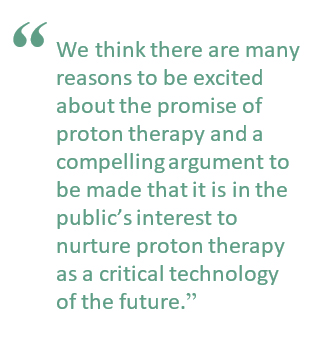 published data on the comparative effectiveness of proton therapy in their decision making. They claim the organization also disregarded the technologic innovations that are rapidly ensuring that proton therapy becomes more affordable and enabling expansion of patient access to the treatment. Because of this, the physicians believe proton therapy should be excluded from the RO APM. This would provide proton centers time to gather additional data on comparative effectiveness and complete ongoing clinical trials to further clarify proton therapy’s value.
published data on the comparative effectiveness of proton therapy in their decision making. They claim the organization also disregarded the technologic innovations that are rapidly ensuring that proton therapy becomes more affordable and enabling expansion of patient access to the treatment. Because of this, the physicians believe proton therapy should be excluded from the RO APM. This would provide proton centers time to gather additional data on comparative effectiveness and complete ongoing clinical trials to further clarify proton therapy’s value.
“We think there are many reasons to be excited about the promise of proton therapy and a compelling argument to be made that it is in the public’s interest to nurture proton therapy as a critical technology of the future. Government leaders have invested large subsidies into developing green energy and other technologies that are more costly than conventional options, but which hold great promise to improve the environment and public health in the future. Why then would we not want to invest in a form of radiation therapy that is just as effective against cancer and exposes less of the body to radiation’s harmful effects?”




Sad Story with A Lesson
A 70-year-old gentleman – let’s call him “John” – contacted Bob Marckini last month inquiring about proton therapy. A friend had told him about the treatment and he wanted to know if he was a candidate. After reminding John that we’re not physicians and can’t give medical advice, only our opinion, Bob asked about his cancer staging.
“My PSA is 535; Gleason score is 4+5=9; and I’m a T2b,” John answered. He also informed Bob that the cancer had metastasized to his spine and several other parts of his body.
Wondering why this gentleman’s cancer was so advanced, Bob learned that although John was having annual physicals, he hadn’t had his PSA measured or a digital rectal exam since 2012. Everything had been “normal” at that time.
“So why did you have your PSA tested now?” Bob asked.
“Because I was having a lot of pain,” said John. “I also had great difficulty urinating. And when I did urinate, I was passing blood. That’s when the doctor started running a bunch of tests and the prostate cancer was found.”
Sad to say, this patient isn’t a candidate for any form of localized treatment for prostate cancer. He’s on androgen deprivation therapy (ADT) and is scheduled for chemotherapy.
When Bob asked why John’s doctor stopped PSA testing and digital rectal exams nine years ago, he learned that his doctor believed PSA testing was overdone and men were being harmed by biopsies and surgeries for early-stage disease. “My primary care doc is a really nice guy,” said John. “We spent most of the time at my annual physicals chatting about subjects we were both interested in.”
This is tragic. And it goes right to the heart of what Bob writes about in his book. Chapter 18 is dedicated to “Ten Steps for Taking Control of the Detection and Treatment of Your Prostate Cancer.” This chapter could also have been titled, “Ten Steps for Taking Control of your Health,” because many of the steps are the same for both objectives.
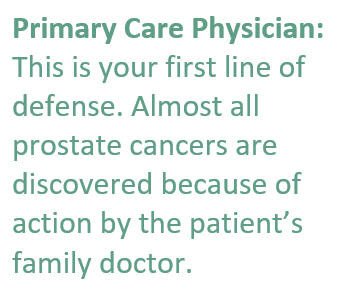 The first, and most important step, is “Choose Your Doctors Wisely.” It begins, “Primary Care Physician: This is your first line of defense. Almost all prostate cancers are discovered because of action by the patient’s family doctor.” John’s doctor was apparently a friend and “a really nice guy.” But his failure to conduct a couple of simple, routine tests over a nine-year period, resulted in his patient having to deal with advanced prostate cancer that will likely shorten his life.
The first, and most important step, is “Choose Your Doctors Wisely.” It begins, “Primary Care Physician: This is your first line of defense. Almost all prostate cancers are discovered because of action by the patient’s family doctor.” John’s doctor was apparently a friend and “a really nice guy.” But his failure to conduct a couple of simple, routine tests over a nine-year period, resulted in his patient having to deal with advanced prostate cancer that will likely shorten his life.
In Chapter 17, Bob addresses the subject of “The Big PSA Controversy.” He presents the positions taken by the American Cancer Society, the American College of Physicians, the American Urological Association, the National Comprehensive Cancer Network, and the U.S. Preventive Service Task Force … and their recommendations are all different! Their guidance ranges all over the place with regard to risk levels, age when PSAs should be started, life expectancy, when to stop PSA testing, and much more.
Bob adds: “How does one navigate through this convoluted mess? The answer to this question is one of the reasons I wrote this book.”
Bob then writes, “My Position on PSA Screening,” on page 227: “Although PSA isn’t the perfect test, it’s considered by most prominent urologic oncologists to be one of the most successful biomarkers in the history of oncology.
Knowing that the PSA test is a non-specific test for detecting prostate cancer, it’s still a valuable relative indicator and can be an early warning signal that you should pay attention to.”
He adds: “In my opinion, all men 50 and older should have annual PSA tests with no upper age limit (Note: one member of our group was diagnosed and treated at age 87. He lived 15 more years to 102). Men at higher risk (e.g. African American or close relative with prostate cancer) should begin PSA screening at age 40.”
John wouldn’t have found himself in this awful predicament if he’d:
- Taken the initiative to learn more about men’s health and the routine testing that he should be having during his annual physicals, and/or;
- Taken the time to find a quality primary care physician who is thorough, proactive, and aggressively screens for all important health issues, particularly those that may affect men in their 60s and 70s.
Once more quote from Bob’s book:
“The best time to select a good doctor is when you don’t need one.”




Should You Wait for the “Best” COVID-19 Vaccine?
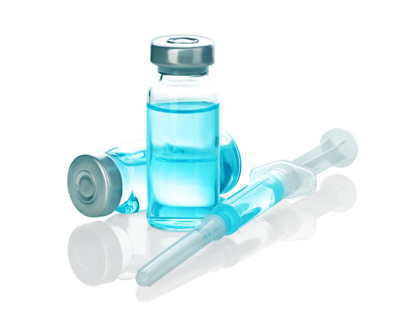 No! Take whatever approved vaccine you can get, according to the president’s advisory board and noted epidemiologist, Dr. Michael Osterholm. “Waiting for the right vaccine is the worst thing you can do to lower your risk of getting severely ill and dying of COVID-19,” say these experts.
No! Take whatever approved vaccine you can get, according to the president’s advisory board and noted epidemiologist, Dr. Michael Osterholm. “Waiting for the right vaccine is the worst thing you can do to lower your risk of getting severely ill and dying of COVID-19,” say these experts.
NewsMax ran a story on this subject on Feb. 12, titled, “Take Any COVID-19 Vaccine Available.”
Some people are apparently planning to avoid the Johnson & Johnson one-dose vaccine because its reported to stop only 66 percent of COVID infections while Pfizer and Moderna’s two-dose versions have protection in the mid-90 percent range.
There are, in fact, seven COVID-19 vaccines that have completed large, comprehensive efficacy trials. They include Pfizer, Moderna, Johnson & Johnson, Novavax, AstraZeneca, Sputnik V, and Sinovac. All appear to be 100 percent effective at preventing serious complications and not a single vaccinated person has died of COVID-19, say the article’s authors.
In Israel, about 90 percent of people 60 and older have been vaccinated, resulting in a 41 percent drop in confirmed COVID cases, according to Nature magazine. These are “early and very encouraging signs that the vaccine is working in the population,” says Florian Krammer, a virologist at Icahn School of Medicine at Mount Sinai in New York City.
It’s not worth the risk of waiting for “the best” vaccine. “Every day that passes without getting vaccinated is a day where you have a higher risk of getting infected, becoming seriously ill and dying,” according to USA Today. “The best thing you can do is get vaccinated as soon as you’re able with whichever vaccine is available to you.”

Surprised and Humbled …
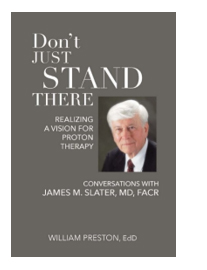 Last month, we let our readers know how to get their hands on a pre-published copy of Dr. William Preston’s book, Don’t Just Stand There – Realizing a Vision for Proton Therapy: Conversations with James M. Slater, MD, FACR. In an effort to boost funding for basic and clinical proton therapy research on prostate cancer, pancreatic cancer, liver cancer, breast cancer, and more, we asked our readers to donate $100 (or more) to Loma Linda University Cancer Center. In return, they’d receive an advanced copy of Preston’s book.
Last month, we let our readers know how to get their hands on a pre-published copy of Dr. William Preston’s book, Don’t Just Stand There – Realizing a Vision for Proton Therapy: Conversations with James M. Slater, MD, FACR. In an effort to boost funding for basic and clinical proton therapy research on prostate cancer, pancreatic cancer, liver cancer, breast cancer, and more, we asked our readers to donate $100 (or more) to Loma Linda University Cancer Center. In return, they’d receive an advanced copy of Preston’s book.
The book, which contains high-quality, color images and illustrations, is not only about Dr. Slater’s quest to create the world’s first hospital-based proton treatment center, it’s also a teaching guide. As the Proton Treatment & Research Center at Loma Linda was such an immense endeavor, Dr. Slater wondered if the aspects of conceiving, planning, and orchestrating such a project, among others he undertook, might be instructive to others. Over the years, he’d also met people in all walks of life, many of whom had dealt with large and complex problems. He was struck by some of the stories they told about their work: although the fields or disciplines usually had nothing to do with medicine, many experiences were similar. And so, he kept this in mind while he worked on the book with Dr. Preston.
We received dozens of emails from readers in response to our request. We were humbled by their thoughtful messages and surprised by some that notified us they’d sent in checks for well beyond the $100 we’d asked for.
Below is an excerpt from a message we received from BOB member Josué Rosado of Napa, CA. Not only did Josué exceed our expectations in his response to our request for a contribution, he shared with us his reason for giving, including his experience of treatment, and a link to a beautiful video he put together.
Bob Marckini’s book helped “clear the fog” of doubt and uncertainty as to whether I should consider proton therapy for my prostate cancer, and my treatment experience at Loma Linda was extraordinary. So it’s my pleasure to donate $1,000 to proton research at Loma Linda.
During my treatment in 2016, I took advantage of Loma Linda’s entire program: I got my treatments early in the morning so I could spend the day enjoying myself; and I participated in activities including the Tuesday evening potlucks, the Wednesday night educational lectures, and the Thursday evening restaurant tours. Most important, I engaged in a weekly exercise regimen offered at the Drayson Fitness Center. It was especially meaningful to know I was changing my lifestyle by developing healthful habits.
 To me, the capstone of the Loma Linda “Make Man Whole” experience was the spiritual culture and positive, thoughtful attitude of the entire university and staff. I was honored to also attend their Adventist worship services at the University Church each Sabbath. The spiritual aspect of treatment had a huge impact on my life. And the friendships I made during my treatment – and through the Brethren of the Balloon – gave me strength and carried me through...
To me, the capstone of the Loma Linda “Make Man Whole” experience was the spiritual culture and positive, thoughtful attitude of the entire university and staff. I was honored to also attend their Adventist worship services at the University Church each Sabbath. The spiritual aspect of treatment had a huge impact on my life. And the friendships I made during my treatment – and through the Brethren of the Balloon – gave me strength and carried me through...
I’m also thankful for the BOB Tales newsletter because it keeps me informed about prostate cancer and the future of proton therapy research and technology.
This month, I turn 75 years old! I’m strong and in good health – and I’m very grateful! Please watch a video summary of my 45 days at Loma Linda.
So readers, if you’d like to have a copy of this awesome book that likely won’t be available to the public until next year, please send a check for $100 or more, payable to “Loma Linda University Proton Cancer Research” and mail it to:
Loma Linda University Health ● Office of Philanthropy ● PO Box 2000 ● Loma Linda, CA 92354
Please notify Deb Hickey at [email protected] that you’ve sent in your check and your book will be mailed immediately.
We’re sure you’ll thoroughly enjoy the book and we know it will occupy a place of honor in your home. And, you’ll be helping to fund basic and clinical proton research on prostate cancer, pancreatic cancer, liver cancer, breast cancer, and much more with your tax-deductible gift. Thank you!


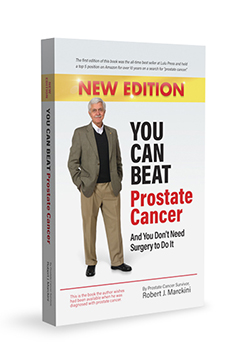 You Can Beat Prostate Cancer: And You Don’t Need Surgery to Do It – Second Edition
You Can Beat Prostate Cancer: And You Don’t Need Surgery to Do It – Second Edition
First Negative Review!
Bob’s book is in the No. 1 position on Amazon out of more than 4,000 books on prostate cancer. It has 63 reviews, almost all 5-star. Several proton centers distribute the book to men who make inquiries, and we know the book influences these patients to choose proton therapy for their prostate cancer. We regularly hear from readers who tell us they love the book and it’s changed their lives. One reader, however, gave us our first negative review:

Insurance coverage denied! Reading this book got me excited about proton therapy. But then it wasn’t until Chapter 13 when Marckini dropped the bomb: your private insurance will probably deny coverage. Insurance is such an important factor that waiting until Chapter 13 is a disservice to the reader. Sure enough, my Excellus BCBS denied pre-approval. I’ll fight for coverage, which the book covers well, but if in the end I have to choose an alternate treatment I will always remember how this book gave me false hope. –R. Hunter
...And we can't blame the reader.
This is the first time we’ve received this type of feedback. And frankly, we can’t blame Mr. Hunter for being frustrated and angry. So much of the book talks about the benefits and superiority of proton therapy over other treatment options, particularly regarding quality-of-life issues. And then the reader learns – more than halfway thought the book – that, because he’s younger than Medicare age, his private insurance likely won’t cover this treatment.
It's all about the money.
When the first edition was published in 2007, private insurers were routinely paying for proton therapy. But, one by one, they recognized that they could change their policy … and save money, using the argument that comprehensive head-to-head clinical trials have never been done to prove that proton therapy is superior to IMRT, and thus justifies the higher cost. Incidentally, comprehensive head-to-head clinical trials have never been done to compare surgery to seeds, conventional radiation to surgery, or surgery to IMRT, yet private insurers pay for all these.
Data Ignored
Dozens of published studies and articles showing proton therapy superiority over conventional radiation in treating so many other cancers, such as brain, breast, and pediatric cancers were apparently ignored by insurers. And, also ignored by insurance companies are independent surveys, where patient-reported data showed proton therapy for prostate cancer scoring extremely well in post-treatment sexual function, urinary function, and bowel function responses.
Here's the good news.
The good news is that two comprehensive clinical trials are under way comparing proton therapy to IMRT head-to-head. Next month we’ll provide an update on the larger of these studies, the COMPPARE trial. Both Bob Marckini and Deb Hickey are actively involved in this trial through executive board and committee participation, respectively. We are confident that these studies, when completed over the next few years, will resolve the question once and for all.
Regarding Mr. Hunter’s criticism, we agree with him. Bob has begun collecting information for the next edition of his book, and the private insurance challenge will be mentioned much earlier in the book. But who knows? By the time the next edition is ready, maybe the newest clinical trials will be completed, and the question of private insurance coverage will be a moot point.
Did you find Bob’s new book valuable? Please write a review on Amazon.
Reminders
We’re happy to discount books in quantity (minimum 20) to anyone interested in spreading the word on proton therapy. Just send an email to [email protected]. Proceeds from book sales are used to help fund our efforts and to support proton therapy research.
The Kindle version is free to Kindle Unlimited members or can be purchased for $9.99 for non-members. The paperback price is $22.45
Buy You Can Beat Prostate Cancer second edition on Amazon or Lulu Press.


YOU are making a difference!
Our Mission
Newer members of our organization may not be familiar with our stated mission, which is 1) To provide communication, information, and support to our members on topics of interest, including the latest developments in proton therapy,  preventing a cancer recurrence, and general health tips, 2) To promote proton therapy for prostate cancer in our communities and beyond, and 3) To give back to the institution that saved our lives and preserved the quality of our lives.
preventing a cancer recurrence, and general health tips, 2) To promote proton therapy for prostate cancer in our communities and beyond, and 3) To give back to the institution that saved our lives and preserved the quality of our lives.
We started out more than 20 years ago as an organization consisting entirely of patients treated at Loma Linda University Cancer Center. Back then, it was the only proton treatment center in the country. Thanks to the pioneering work of Dr. James Slater, Dr. Jerry Slater, and Loma Linda, there are 36 proton centers in the U.S. and more than 50 others around the world. And today, we have members who were treated at all U.S. proton centers as well as many from centers in Europe and Asia.
A Great Honor
A few years ago, Bob Marckini was greatly honored to be invited to a Loma Linda University Health (LLUH) board meeting, where BOB member Chuck Kubicki, a real estate developer from Cincinnati and now a close friend of Bob’s, announced the establishment of the Robert J. Marckini Endowed Chair for Proton Therapy Research. Mr. Kubicki “seeded” the new chair with a generous contribution.
Update on BOB Giving
We just learned that the Marckini Chair has reached the level of $3.8 million and has been actively funding proton therapy research at Loma Linda. We also learned that total BOB member giving to LLUH, including their Vision2020 campaign, has reached $13 million! This $13 million consists of members who’ve made single gifts, annual gifts, and many who make monthly gifts through automatic payments from their bank accounts. It also includes planned gifts, where members notify us of the approximate amount they plan to give after their death through their estate plan.
Gifts are often given to honor someone at the medical center or even a friend or family member. When gifts are given in honor of individuals, a letter is sent from LLUH notifying the honoree that a gift has been made in their honor. This is a wonderful way to honor someone special and to fund an important cause at the same time.
In 2020, BOB members made gifts totaling more than $400,000. We want to sincerely acknowledge all those who have made gifts last year which ranged from $25 to tens of thousands of dollars.
You are making a difference!
If you’d like to make a gift to thank Loma Linda University Health for their pioneering efforts that made your proton treatment possible, or to acknowledge the BOB organization for our BOB Tales newsletter or the services we provide, please consider one of the following.
- Donate to proton research online.
- Write a check to LLUCC Proton (Put “Marckini Chair” on the memo line) and mail to LLUH, Office of Philanthropy P.O. Box 2000, Loma Linda, CA 92354.
- Make an unrestricted gift (put “unrestricted” on memo line) so LLUH can use it where it’s needed most.
- Call Regina Joseph at 909-558-5010 to donate over the
phone and/or to inquire about naming opportunities.

“Health Screenings and Vaccinations You Need in 2021”
This is the title of an article by syndicated health writer, Sheryl Kraft. Sheryl covers all aspects of health and is published in 25 journals across the nation, including JAMA, AARP, Fitness Republic, HealthyWomen, Family Circle, Weight Watchers and Prevention.
In her most recent article, she notes that Covid-19 concerns have prompted a high percentage of our population to delay or cancel routine health visits. She cautions that there are common afflictions, such as heart attacks, IBS, strokes, cancers, and diabetes that can greatly benefit from routine testing during annual physicals.
In her article she summarizes health screening recommendations from the United States Preventive Services Task Force (USPSTF) and others. Here’s an abstract of what she had to say.
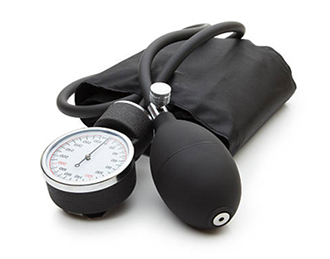 Recommended Health Screenings
Recommended Health Screenings
Blood Pressure: All adults 50 and over should test regularly. This can help identify and prevent heart disease, stroke, kidney disease, and more.
Cholesterol: This is a simple blood test that can help prevent and detect heart disease or diabetes.
Stomach, Colon, Rectal Issues: Colorectal screenings are recommended every five to 10 years beginning at age 45. Various forms of this test can detect and remove precancerous growths before they become a problem.
Dental: Surprisingly, health problems such as stroke, diabetes and heart disease can be linked to gum disease. Your dentist should be visited every six months, and every four months if you have periodontal problems.
Depression: This serious health issue has skyrocketed during the pandemic. Depression can lead to an increased risk of suicide, drug or alcohol addition and a compromised immune system. Talk with your doctor if you have symptoms.
Diabetes: Monitor your glucose levels. If elevated you may have insulin resistance, prediabetes and/or Type 2 diabetes, which can lead to kidney failure, amputations, heart disease and blindness. Overweight people age 50 and older, especially with high blood pressure should be screened.
Eye: Glaucoma, macular degeneration, and cataracts are common with age. A comprehensive eye examination is recommended at least every two years. This testing can also help detect diabetes and autoimmune diseases.
Hearing: Hearing loss increases with age. Baseline screening at age 50 is recommended and then repeated every three years. Anxiety, depression and dementia can result from untreated hearing loss.
Lungs: Low-dose CT scan for people with a history of smoking can help reduce the risk of dying from lung cancer.
Skin: Annual head-to-toe skin examinations by a dermatologist are recommended to help detect melanoma and other skin cancers. Treatment is often simple with early detection.
Body Weight: Obesity is a serious problem in the U.S. and can lead to heart disease, stroke, Type 2 diabetes and cancer.
PSA and DRE: Though not mentioned in the article, we would like to suggest that men age 50 and older (or 40 an older if at higher risk) should have their PSA tested as well as a digital rectal exam (DRE) on an annual basis.
More screening recommendations are presented in the article, including specific screening tests for women and men.
Recommended Vaccinations
Pneumonia: For all adults 65 and older
Influenza: For everyone – those 65 and older should consider the high-dose version.
Shingles: Two doses of Shingrix is recommended for all adults 50 and older.
Tdap: This protects against pertussis (whooping cough) and should be given to all adults who did not receive it as an adolescent.
Td Booster: This protects against tetanus and diphtheria and is recommended every 10 years.
COVID-19: At this point in time, everyone other than children and pregnant women should consider getting this vaccine.




Gene Discovery Reveals Importance of Eating Greens
We’ve reported many times that eating vegetables can serve to improve your health and help ward off several cancers, including prostate cancer. Turns out, there are even more benefits to eating greens. Researchers at the Walter and Eliza Hall Institute of Medical Research in Australia discovered an immune cell population essential for intestinal health can be controlled by leafy greens in the diet. The cells – called innate lymphoid cells – live in the lining of the digestive system and protect the body from “bad” bacteria. They also help to control food allergies, inflammatory diseases, and obesity, and may even prevent the development of bowel cancers.
We’ve reported in past BOB Tales that numerous studies have shown that cruciferous vegetables can help prevent prostate cancer. When people think of cruciferous vegetables, they mostly think of broccoli, cauliflower, and Brussels sprouts. But the list is much longer:
Cruciferous Vegetables
Arugula Bok choy Broccoli Brussels sprouts
Cabbage Cauliflower Collard greens Garden cress
Horseradish Kale Mustard seed/leaves Radish
Rutabaga Turnips roots/greens Wasabi Watercress
Read the complete list of cruciferous veggies.


We’ve been producing BOB Tales newsletters monthly for 20 years. During this time there have been articles that many new members haven’t seen, and some older members may have forgotten. So, we periodically re-run some articles from past newsletters. The following is from June 2006.
Recognizing a Stroke
Neurologists say that if they can get to a stroke victim within three hours, they can usually reverse the effects of a stroke … completely. The trick is getting a stroke recognized, diagnosed, and cared for within three hours, which can be a challenge.
You can save a life if you remember the “3” steps, STR. Read and Learn! Sometimes symptoms of a stroke are difficult to identify. Unfortunately, the lack of awareness spells disaster. The stroke victim may suffer severe brain damage when people nearby fail to recognize the symptoms.
Doctors say a bystander can recognize a stroke by asking three simple questions:
S: Ask the individual to smile.
T: Ask the person to talk. Ask him/her to say a simple sentence, coherently.
R: Ask him/her to raise both arms.
NOTE: Another sign of a stroke is this: Ask the person to stick out their tongue. If the tongue is crooked – if it goes to one side or the other – that may also be an indication of a stroke.
If the victim has trouble with any one of these tasks, call 911 immediately and describe the symptoms to the dispatcher.


National Proton Conference: April 2021
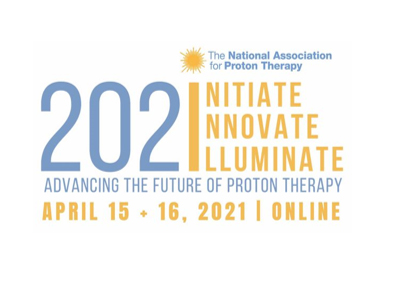 The National Association for Proton Therapy (NAPT) is the voice of the proton therapy community ─ providing education and awareness for the public, professional, and governmental stakeholders about the benefits of proton therapy for treating cancer.
The National Association for Proton Therapy (NAPT) is the voice of the proton therapy community ─ providing education and awareness for the public, professional, and governmental stakeholders about the benefits of proton therapy for treating cancer.
Join NAPT for the ninth annual National Proton Conference, April 15 & 16, 2021. NAPT will bring together the community in a virtual format that builds on the success of their 2020 virtual education opportunities with the addition of new opportunities and features.
This year NAPT continues their mission to educate and increase awareness about the clinical benefits of proton therapy, ensure patients' choice and access, and to encourage cooperative research and innovation. NAPT is committed to move the proton industry forward and look forward. The proton community has united through the opportunities these challenging times have presented and their continued goal is to connect the brightest minds and visionaries in the field to advance the future of proton therapy ─ a future shaped by collaboration to initiate, illuminate, and innovate.
Topics Will Include …
- Latest research on proton therapy
- Proton therapy insurance coverage and reimbursement
- Flash Therapy
- Developing and incorporating particle therapy into a cancer program
- Updates on key health policies impacting cancer care
- Marketing and Public Relations
- Trends in particle therapy for the future
- Ensuring value in alternative payment models
- Best practices for clinical and business operations



Last Month’s Brain Teaser
B, E, J, Q, X, Y AND Z are the only letters in the alphabet not included among the first letters of a certain group of names. What is the name of the group?
Answer: The United States of America. No state names begin with B, E, J, Q, X, Y or Z.
Winner: The February BOB Tales brain teaser winner is Ralph Swarthout of Fairbanks, AK! “I can hardly believe I won the brain teaser! This put a smile on my face,” wrote Ralph in an email to Deb Hickey. Well, that put a smile on Deb’s face, so we’re all smiling now.
Ralph was treated for his prostate cancer in the spring of 2020 – just about the time COVID-19 was spreading throughout the country. “What we’d imagined as a ‘radiation vacation’ at Loma Linda like we’d heard about turned into my wife and me spending a lot of time together in our rental apartment,” said Ralph.
Ralph’s PSA started to rise in late 2018, so his doctor ordered a biopsy. When it came back negative, Ralph was relieved. However, his PSA continued to rise. He had another biopsy in the fall of 2019, and he learned he had high-grade prostate cancer.
► BOB Comment: We checked with Ralph on this and weren’t surprised to learn he’d had a “blind” biopsy. Had Ralph’s doctor initially used MRI imaging to pinpoint the location of any suspicious lesions, we think Ralph would have been diagnosed much sooner and with a lower-grade cancer. This relates to our previous story, “A Sad Story with a Lesson,”but we’re grateful Ralph was able to catch his cancer before it spread to other parts of his body and was able to undergo proton therapy.
“I immediately called Loma Linda University Cancer Center and scheduled a consultation,” Ralph said. Lucky for him, he had two work associates who had been treated for prostate cancer with proton therapy at LLUCC and were doing well, so Ralph had “pretty much already decided” to undergo proton treatment. “One of my colleagues gave me a copy of Bob Marckini’s book, which was very helpful,” Ralph said.
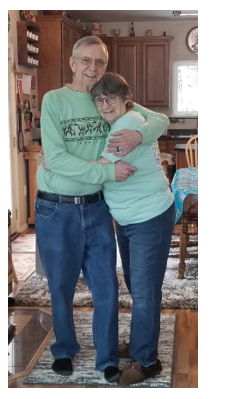 Ralph and his wife, Marilyn, were sorry to “miss out” on the activities they’d heard so much about and the camaraderie among other patients, but they realized the most important thing was to get rid of the cancer in the most effective way possible. “You just have to take life as it comes,” said Ralph. “And I was very fortunate that I was able to successfully complete my treatment safely.”
Ralph and his wife, Marilyn, were sorry to “miss out” on the activities they’d heard so much about and the camaraderie among other patients, but they realized the most important thing was to get rid of the cancer in the most effective way possible. “You just have to take life as it comes,” said Ralph. “And I was very fortunate that I was able to successfully complete my treatment safely.”
Ralph’s last PSA reading was low and he’s feeling well. “I’m already looking forward to my next visit with my urologist,” he said.
Ralph and Marilyn spend most of their time at home these days due to the pandemic. Fortunately, they’ve both received their two COVID-19 vaccinations and are looking forward to taking a cruise when it’s safe to do so.
The photo of Ralph and Marilyn was taken on their 50th wedding anniversary on Jan. 30, 2021.




New Brain Teaser/Riddle
When liquid splashes me, none seeps through.
When I am moved a lot, liquid I spew.
When I am hit, color I change,
And color, I come in, quite a range.
What I cover is very complex,
And I am very easy to flex.
What am I?
Send your brain teaser/Riddle answer to [email protected] for a chance to win a signed copy of Bob Marckini’s NEW second edition book, You Can Beat Prostate Cancer.




Why?
Why is the third hand on the watch called the second hand?
Why do we say something is out of whack? What is a whack?
Why does “fat chance” and “slim chance” mean the same thing?
Why do we sing “take me out to the ball game” when we’re already there?
Why are they called “stands” when they’re made for sitting?
Why are a “wise man” and a “wise guy” opposites?
Why do “overlook” and “oversee” mean opposite things?
Why do we put suits in garment bags and garments in a suitcase?
Why do they call it a TV set when you have only one?
Why do we drive on a parkway and park on a driveway ?




A Golf Story
Four old guys went into the pro shop after playing 18 holes of golf. The pro asked, “Did you guys have a good game today?” The first old guy said, “Yes, I had three riders today.” The second old guy said, “I had the most riders ever. I had five.” The third old guy said, “I had seven riders – the same as last time.” The last old man said, “I beat my old record. I had 12 riders today.”
After they went into the locker room, another golfer who’d heard the old guys talking about their game went to the pro and said, “I’ve been playing golf for a long time, and thought I knew all the terminology of the game, but what’s a rider?” The pro said, “A rider is when you hit the ball far enough to get in the golf cart and ride to it.”

Quote of the Month: “Don't believe everything you read on the Internet.” —Abraham Lincoln




Better than Biscuits
A friend on social media shared this story …
A while back I read a story of a visiting pastor who attended a men’s breakfast in the middle of a rural farming area of the country. The group had asked an older farmer, decked out in bib overalls, to say grace for the morning breakfast.
“Lord, I hate buttermilk,” the farmer began. The visiting pastor opened one eye to glance at the farmer, wondering where this was going. The farmer loudly proclaimed, “Lord, I hate lard.” The pastor was growing concerned. Without missing a beat, the farmer continued, “And Lord, you know I don’t much care for raw white flour.” The pastor again opened an eye to glance around the room and saw he wasn’t the only one feeling uncomfortable.
Then the farmer added, “But Lord, when you mix them together and bake them, I do love warm fresh biscuits. So, Lord, when things come up that we don’t like; when life gets hard; when we don’t understand what You are saying to us – please help us to just relax and wait until you’re done mixing. It will probably be even better than biscuits. Amen.”
Within that prayer there is great wisdom for all when it comes to complicated situations like we’ve been dealing with recently and throughout history.
What are the buttermilks, lards, and raw white flours in your life? Keep praying and asking God to reveal to you what He’s mixing. I’d venture to guess that when He’s done mixing, you will come out with something even better than biscuits.
Low PSAs to all,
Bob Marckini and Deb Hickey
To print the BOB Tales newsletter or view the newsletter with a larger font size, click here for the PDF file.
NO MEDICAL ADVICE: Material appearing here represents opinions offered by non-medically-trained laypersons. Comments shown here should NEVER be interpreted as specific medical advice and must be used only as background information when consulting with a qualified medical professional.
